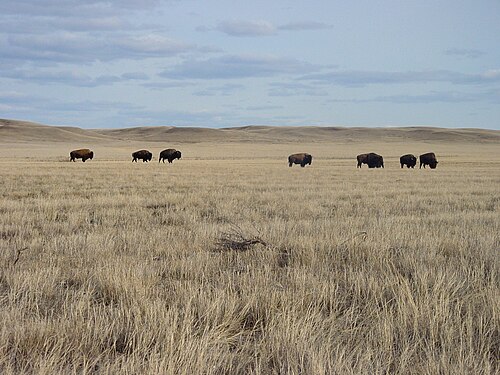| Grasslands National Park | |
|---|---|
| Parc national des Prairies | |
 Bison grazing in Grasslands National Park | |
 Interactive map of Grasslands National Park | |
| Location | RM of Val Marie No. 17,Saskatchewan,Canada |
| Nearest city | Val Marie |
| Coordinates | 49°09′N107°31′W / 49.15°N 107.51°W /49.15; -107.51 |
| Area | 907 km2 (350 sq mi) |
| Established | 1981 |
| Visitors | 19,656 (in 2022–23[1]) |
| Governing body | Parks Canada |
| Grasslands National Park | |
Grasslands National Park is aCanadian national park located near the village ofVal Marie,Saskatchewan, and one of 44 national parks and park reserves inCanada's national park system (though one of only two in Saskatchewan itself). This national park is north of theU.S. state ofMontana and lies adjacent to theinternational boundary. It consists of two separate parcels, the East Block and West Block.
The park was established in 1981. Prior to this the province's only national park wasPrince Albert National Park. Grasslands annually receives about 12,000 visitors.
Grasslands National Park represents the Prairie Grasslands natural region, protecting one of the nation's few remaining areas of undisturbed dry mixed-grass/shortgrass prairiegrassland.[2] The park is located in theWorld Wildlife Fund-defined Northern short grasslands ecoregion, which spans much of southern Saskatchewan, southernAlberta, and the northernGreat Plains states in the US. The unique landscape and harsh,semi-arid climate provide niches for several adapted plants and animals. The park and surrounding area house the country's onlyblack-tailed prairie dog colonies. Fauna found in the park includebison,pronghorns,greater sage-grouses,ring-necked pheasants,burrowing owls,coyotes,ferruginous hawks,swift foxes,prairie rattlesnakes,black-footed ferrets,eastern yellow-bellied racers, andgreater short-horned lizards.[3][4] Flora includesblue grama grass,needlegrass,plains cottonwood andsilver sagebrush.[5]

Erosion by glacialmeltwater formed many of the park's characteristic features. Highlights of the park's geological landscape include theFrenchman River Valley, the Seventy Mile Butte, and thebadlands of Rock Creek.
In 1874, SirGeorge Mercer Dawson discoveredWestern Canada's firstdinosaur remains[6] in the Killdeer Badlands during theInternational Boundary Survey. Later, in 1877,Sitting Bull took refuge in the area with around 5,000Sioux after the defeat ofGeneral Custer at theBattle of Little Bighorn.[7]
Grasslands National Park isTreaty 4 land of theBlackfoot (Niitsítapi) people of the Canadian and American plains.[8] A 2022 agreement between theMétis Nation - Saskatchewan and Parks Canada provides for the transfer of 24 bison.[9]

The West Block of the park is located one hour south ofSwift Current, and the main visitor reception centre is located in the town ofVal Marie. Highlights of the West Block include theFrenchman River Valley, a herd of over 300plains bison as well asprairie dog colonies. A 16-kilometre (10 mi) wide stretch of land on either side of the Frenchman River is anImportant Bird Area of Canada calledGrasslands National Park (west) (SK 024).[10] Frenchman Valley Campground offers visitors servicedcamping sites,teepee camping, and a cook shelter.Backcountry camping is also available.[11] The West Block is located inCensus Division No. 4.
The East Block of the park is located about an hour's drive south ofAssiniboia on the south side of theWood Mountain Hills inCensus Division No. 3. The interpretive centre is in the McGowan House at the new Rock Creek Campground and the information centre is at the museum inWood Mountain Regional Park.[12] The East Block is more of a wilderness area but has views of thebadlands of Rock Creek, theCretaceous–Paleogene boundary, and prairie skies. A one-lane, 11-kilometre (6.8 mi) parkway traverses the Rock Creek Badlands.[13] The East Block contains theGrasslands National Park (east) (SK 023) Important Bird Area.[14]
In 2006, plains bison fromElk Island National Park in Alberta were reintroduced to Grasslands. By 2015, the herd had grown from the original 71 animals to over 300.[15] The herd is maintained on a 181 km2 (70 sq mi) section in the park's West Block. On 2 October 2009, the Royal Astronomical Society of Canada designated Grasslands National Park adark-sky preserve,[16] and a small population ofblack-footed ferrets were reintroduced into the prairie dog towns after a 70-year absence. Improved night-lighting practices under the dark-sky agreement ensure that the park remains dark at night, preserving a natural environment for all nocturnal wildlife.[17]
 Media related toGrasslands National Park at Wikimedia Commons
Media related toGrasslands National Park at Wikimedia Commons
 Canada portal
Canada portal